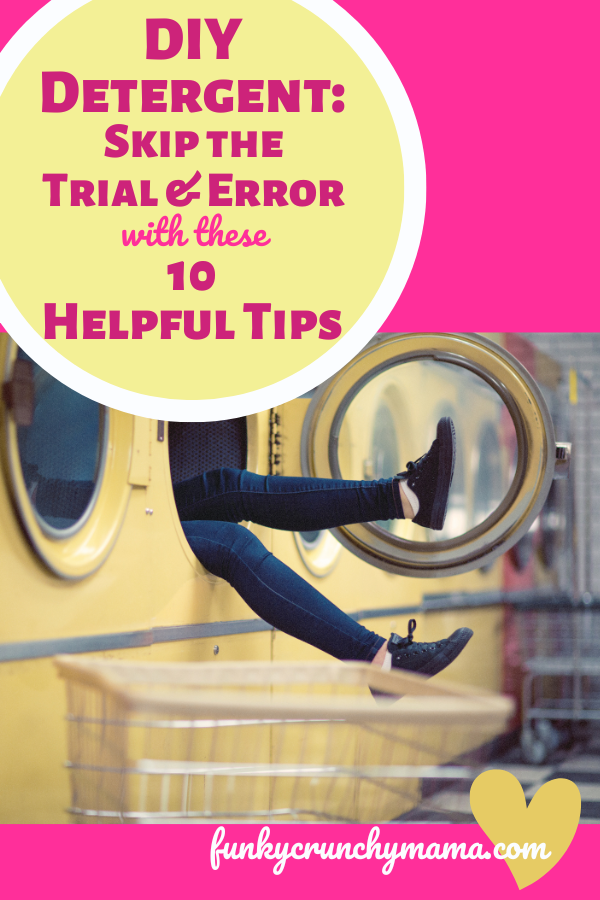DIY detergent is a great way to save money and help the planet, but making your own can be overwhelming. How much do I need? Will I like it? What do I need? How long does it take to make?
Our family has been using DIY detergent for about five years and I can honestly say that I have no intention of ever going back. Buying commercial detergents was always a tough pill to swallow. It’s SO expensive and, as a bit of a crunchy, those giant plastic jugs (which are grossly dripping with blue goo by the end) are heart wrenching to throw into the recycling. Plastic recycling is so inefficient.
In the five years since we’ve started making it, I’ve learned a few tips that I’m so excited to share, ‘cause if they make it easier for you to make, you’re more likely to stick with it, and that’s a win for everyone.

This post contains affiliate links.
1. Store Ingredients in Airtight Containers
No matter what recipe you use, most DIY detergents require two of the same ingredients: borax & washing soda. These products are both white powders that are susceptible to caking in moist environments. This is why it’s important to store them in airtight containers after purchase.
I once failed to do so and ended up with a rock solid box of borax. After a few failed attempts to salvage it, I ended up tossing the whole thing. A big ol’ trial & error waste.
Obviously, your containers don’t need to be fancy or expensive. I keep ours in gallon ice cream buckets. Secondhand kitchen containers would work well, too!
2. Label your containers
This may go without saying, but make sure that you label your ingredient containers. Again, washing soda and borax are white powders that are almost indistinguishably different.
Also, make sure to label the body of the container, not just the lid, especially if you use two of the same containers. Lids can pretty easily become shuffled about when you’re making detergent. If one runs out, how will you know which product to fill the container with?
3. Write your recipe on the container
There are a million different detergent recipes floating around. If you find one that you like, write it down on the container so you don’t need to go searching for it next time you need to make some more.
Don’t have a favorite recipe yet? Here’s mine.
4. Always keep ingredients on hand
Some people take detergent-making very seriously. So seriously, that they’ll clear a store of its ingredients on shipping day. This can make for a big dilemma if you need to make detergent and the three stores nearest you are all out of one (or all) of the ingredients. As such, always keep a full (or nearly full) box of washing soda and borax on hand, as well as several bars of your preferred soap.
5. Make big batches
This may go without saying, but making a large batch at one time rather than small batches at regular intervals is much less overwhelming. If you use my recipe, a quadruple batch fills a gallon bucket and lasts about three months. It also takes less than 30 minutes to make.
I can only imagine that the people clearing store shelves of borax are filling storage bins with detergent or making it to sell. Maybe they give it as holiday gifts….
6. Don’t waste your time grating soap
When I was in my early days of detergent making, I noticed that a lot of recipes said to use a cheese grater to shred the soap. This was so time consuming. And if my soap was hard, you just couldn’t do it.
If you also find this overwhelmingly time-consuming, just chop it with a big kitchen knife. It may need to spend a little extra time in the food processor, but if this keeps you making your own detergent versus buying it? Keep it simple.
7. Properly layer your ingredients in the processor
When you put your ingredients into the food processor, be sure to start with a powder, then soap, then powder. If you start with the soap, the blade’s friction can melt the soap and create a layer along the bottom of the container. Obviously, melting the soap back together defeats the purpose.
Also, putting the soap in the middle seems to make sure it’s evenly distributed, so layer properly.
Keep dust at bay
If you’re using a food processor, it probably kicks up dust in the blending process. This dust isn’t something that you want to inhale, so:
8. Keep the lid on until the dust settles
I generally start chopping my soap for the next batch after I’ve finished processing in order to give the dust a chance to settle. After it’s chopped, I open the food processor and dump the completed batch into the final container before starting the next round.
9. Cover the food processor with a damp towel
Many food processors have holes on the top out of which dust can escape. A damp towel will keep any of the dust that does escape to a minimum and capture the particles more easily.
10. Buy soap you like
Your detergent will take on the scent of your soap. Laundry soaps like Fels Naptha and Zote work well, but you don’t NEED to use them. You can also use your favorite body soap, plant-based soap, or whatever’s cheapest.
The main key in using a soap is to make sure that the weights are equivalent to the recipe you’re using. I frequently make a smaller batch with Chandrika — a sandalwood scented soap — for our shirts because I like the smell. When I do, I need to use two bars. If I use Fels Naptha, I need one bar. If I use Kirk’s castile soap, I use 1 ¼ bars per batch.
In Conclusion
Making your own laundry detergent doesn’t need to be overwhelming. Earth-friendlier detergent brands are popping up all the time, but DIY is always going to be less expensive.
If you’re new to making it and don’t have a food processor, ask around. There’s sure to be someone among your family and friends who isn’t using theirs. If not, check your local secondhand stores. Kitchen gadgets are on my list of five things I always buy secondhand. People buy things they don’t use and then donate them all the time. Food processors are frequently among them.
I hope you find these tips helpful wherever you are on your DIY detergent journey. If you’re a seasoned detergent maker, what would you add or did you find helpful? Let me know in the comments below!
— Melissa, Funky Crunchy Mama








